Impairment of Assets: A Comprehensive Analysis of IAS 36 Standard
VerifiedAdded on 2020/02/24
|8
|1564
|40
Report
AI Summary
This report provides an executive summary of IAS 36, which addresses the impairment of assets. The standard ensures assets are not carried at a value exceeding their recoverable amount, defined as the higher of fair value less costs of disposal and value in use. The report highlights the annual impairment tests for goodwill and certain intangible assets, along with indicators of impairment, testing procedures, and required information. The procedure involves comparing carrying amounts with undiscounted cash flows and measuring the difference between carrying amount and fair value. The report emphasizes the management's lack of flexibility in impairment decisions, as they must comply with the standard's requirements when impairment conditions exist. The conclusion reiterates the core principle of IAS 36, the conditions for impairment, and the importance of management's judgment in assessing impairment factors. References to relevant resources are also included.
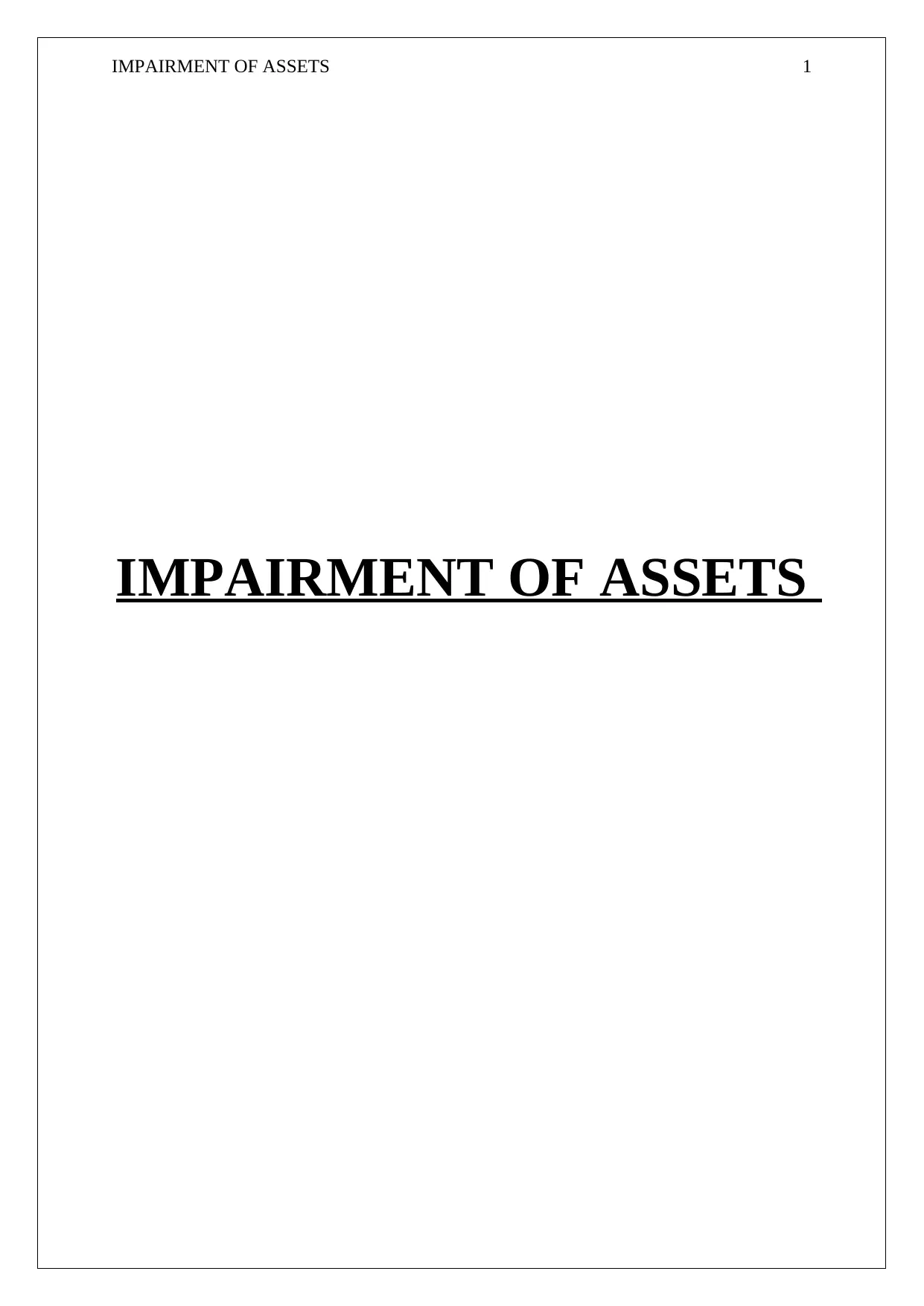
IMPAIRMENT OF ASSETS 1
IMPAIRMENT OF ASSETS
IMPAIRMENT OF ASSETS
Paraphrase This Document
Need a fresh take? Get an instant paraphrase of this document with our AI Paraphraser
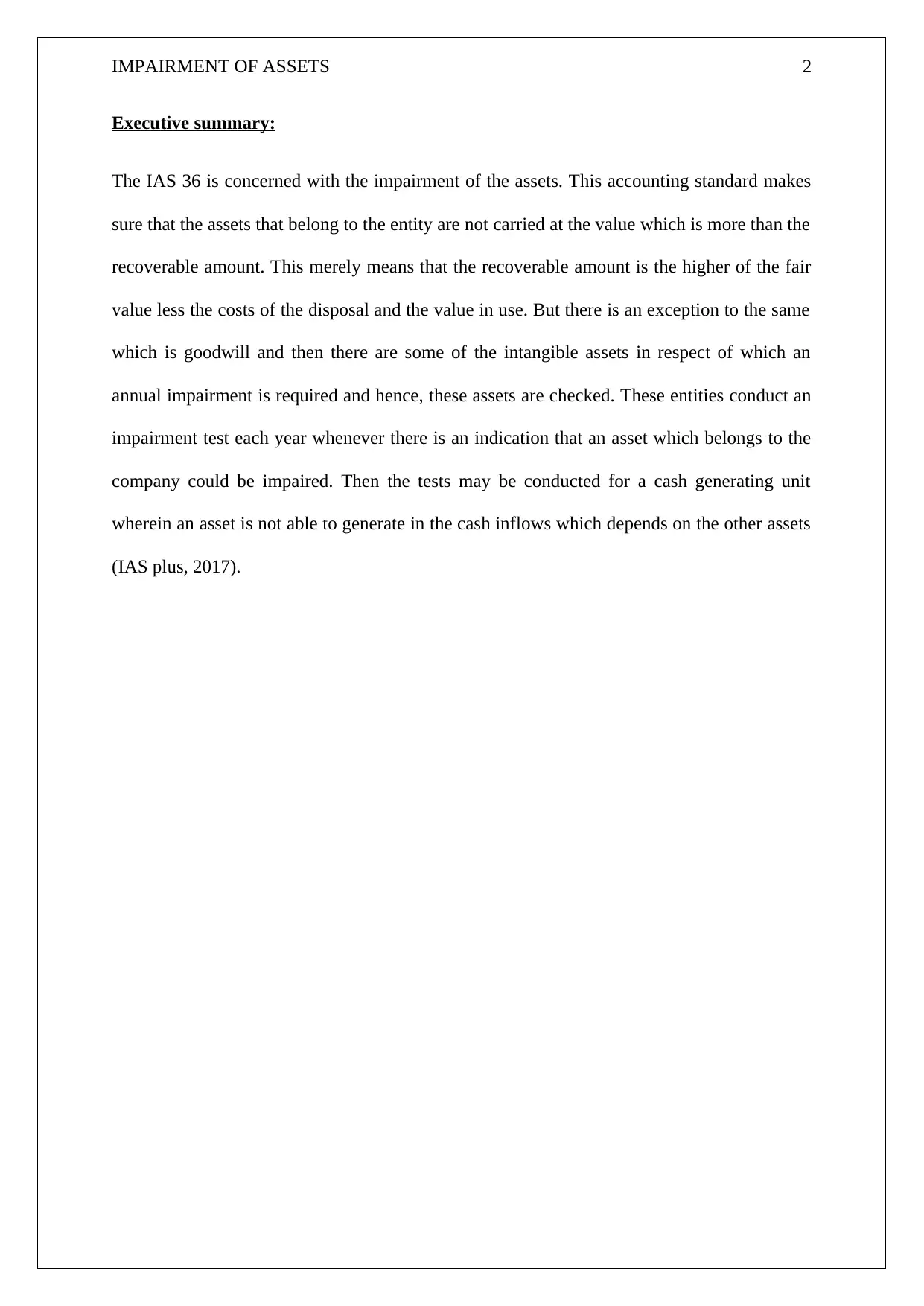
IMPAIRMENT OF ASSETS 2
Executive summary:
The IAS 36 is concerned with the impairment of the assets. This accounting standard makes
sure that the assets that belong to the entity are not carried at the value which is more than the
recoverable amount. This merely means that the recoverable amount is the higher of the fair
value less the costs of the disposal and the value in use. But there is an exception to the same
which is goodwill and then there are some of the intangible assets in respect of which an
annual impairment is required and hence, these assets are checked. These entities conduct an
impairment test each year whenever there is an indication that an asset which belongs to the
company could be impaired. Then the tests may be conducted for a cash generating unit
wherein an asset is not able to generate in the cash inflows which depends on the other assets
(IAS plus, 2017).
Executive summary:
The IAS 36 is concerned with the impairment of the assets. This accounting standard makes
sure that the assets that belong to the entity are not carried at the value which is more than the
recoverable amount. This merely means that the recoverable amount is the higher of the fair
value less the costs of the disposal and the value in use. But there is an exception to the same
which is goodwill and then there are some of the intangible assets in respect of which an
annual impairment is required and hence, these assets are checked. These entities conduct an
impairment test each year whenever there is an indication that an asset which belongs to the
company could be impaired. Then the tests may be conducted for a cash generating unit
wherein an asset is not able to generate in the cash inflows which depends on the other assets
(IAS plus, 2017).
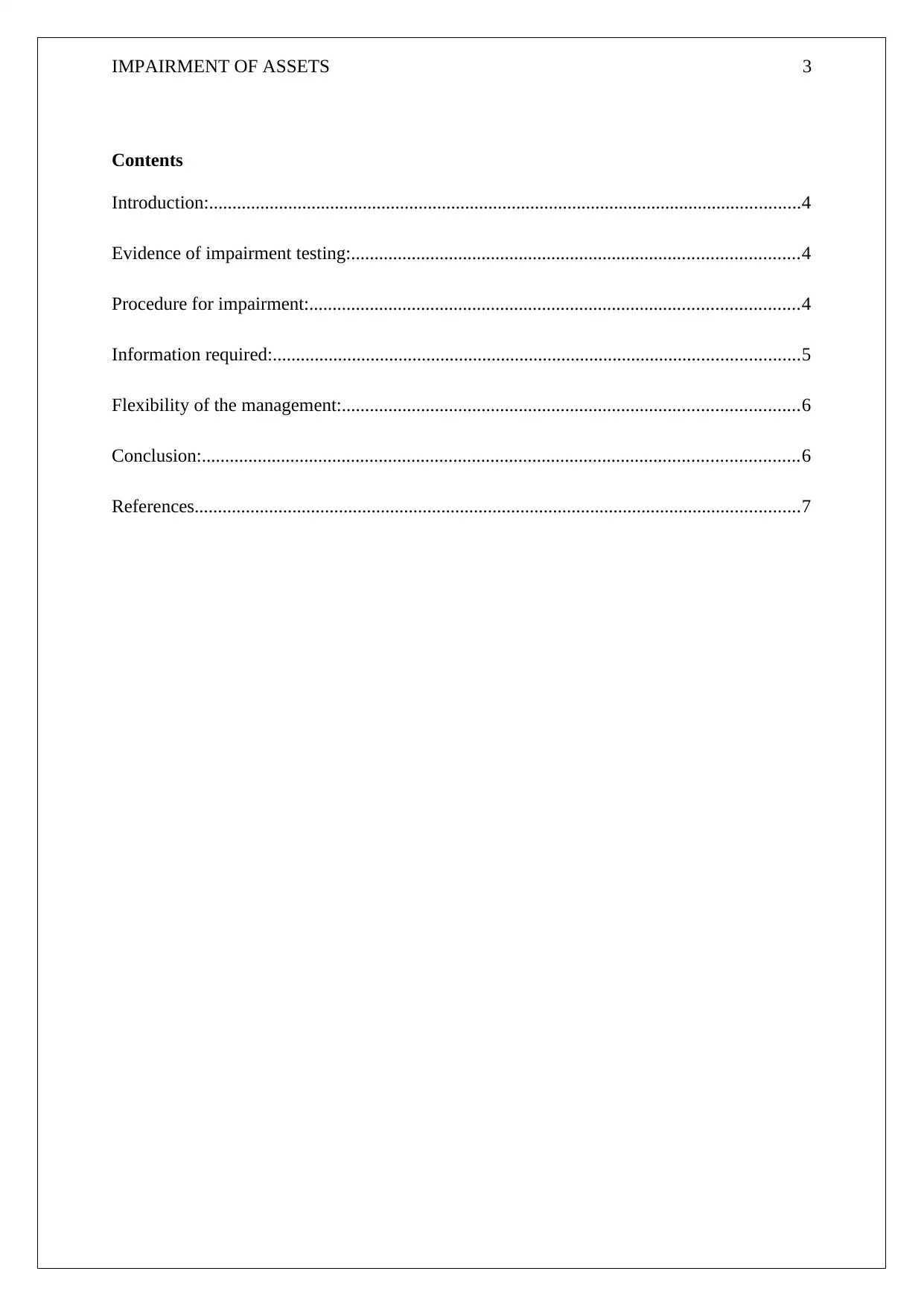
IMPAIRMENT OF ASSETS 3
Contents
Introduction:...............................................................................................................................4
Evidence of impairment testing:................................................................................................4
Procedure for impairment:.........................................................................................................4
Information required:.................................................................................................................5
Flexibility of the management:..................................................................................................6
Conclusion:................................................................................................................................6
References..................................................................................................................................7
Contents
Introduction:...............................................................................................................................4
Evidence of impairment testing:................................................................................................4
Procedure for impairment:.........................................................................................................4
Information required:.................................................................................................................5
Flexibility of the management:..................................................................................................6
Conclusion:................................................................................................................................6
References..................................................................................................................................7
⊘ This is a preview!⊘
Do you want full access?
Subscribe today to unlock all pages.

Trusted by 1+ million students worldwide
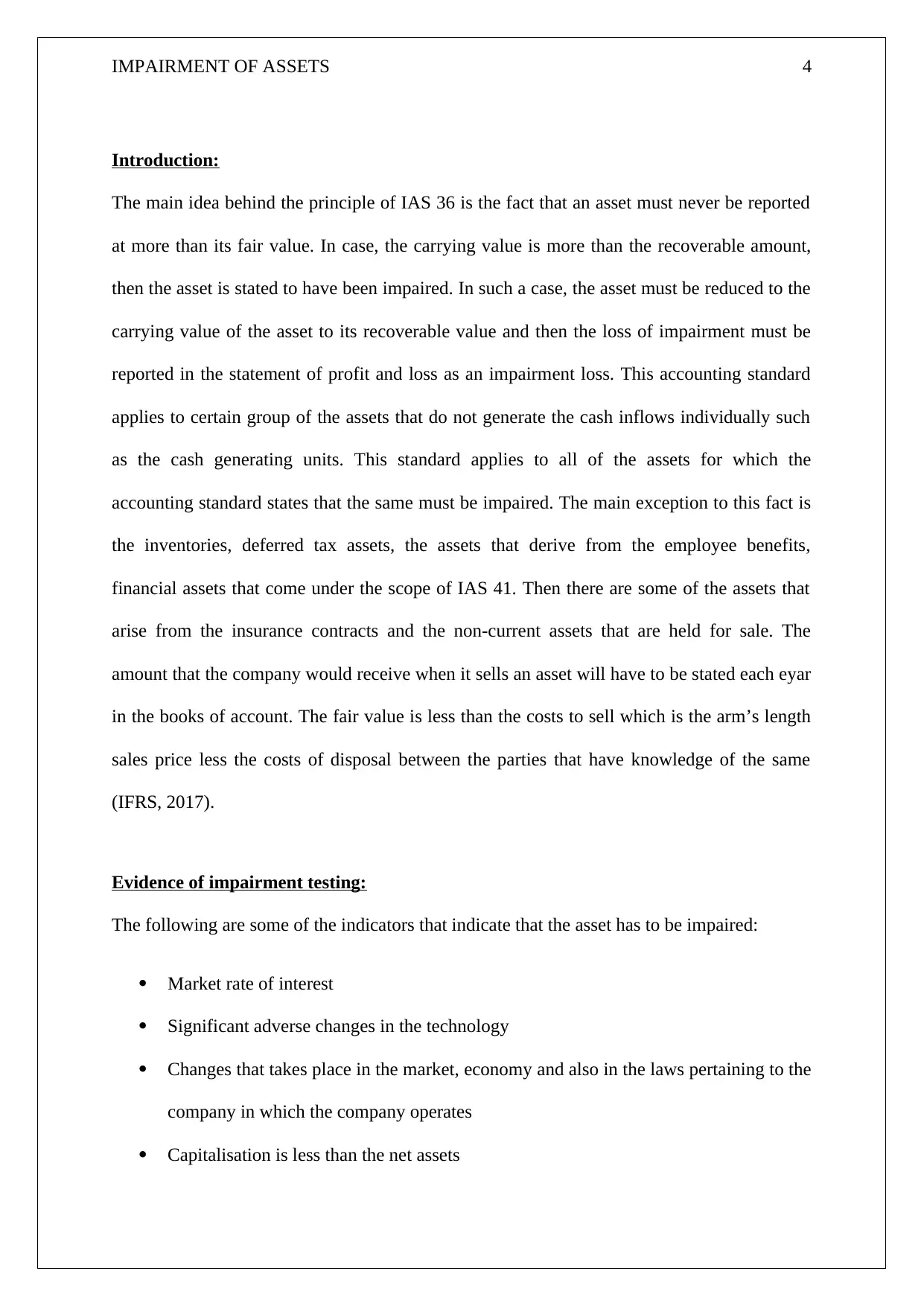
IMPAIRMENT OF ASSETS 4
Introduction:
The main idea behind the principle of IAS 36 is the fact that an asset must never be reported
at more than its fair value. In case, the carrying value is more than the recoverable amount,
then the asset is stated to have been impaired. In such a case, the asset must be reduced to the
carrying value of the asset to its recoverable value and then the loss of impairment must be
reported in the statement of profit and loss as an impairment loss. This accounting standard
applies to certain group of the assets that do not generate the cash inflows individually such
as the cash generating units. This standard applies to all of the assets for which the
accounting standard states that the same must be impaired. The main exception to this fact is
the inventories, deferred tax assets, the assets that derive from the employee benefits,
financial assets that come under the scope of IAS 41. Then there are some of the assets that
arise from the insurance contracts and the non-current assets that are held for sale. The
amount that the company would receive when it sells an asset will have to be stated each eyar
in the books of account. The fair value is less than the costs to sell which is the arm’s length
sales price less the costs of disposal between the parties that have knowledge of the same
(IFRS, 2017).
Evidence of impairment testing:
The following are some of the indicators that indicate that the asset has to be impaired:
Market rate of interest
Significant adverse changes in the technology
Changes that takes place in the market, economy and also in the laws pertaining to the
company in which the company operates
Capitalisation is less than the net assets
Introduction:
The main idea behind the principle of IAS 36 is the fact that an asset must never be reported
at more than its fair value. In case, the carrying value is more than the recoverable amount,
then the asset is stated to have been impaired. In such a case, the asset must be reduced to the
carrying value of the asset to its recoverable value and then the loss of impairment must be
reported in the statement of profit and loss as an impairment loss. This accounting standard
applies to certain group of the assets that do not generate the cash inflows individually such
as the cash generating units. This standard applies to all of the assets for which the
accounting standard states that the same must be impaired. The main exception to this fact is
the inventories, deferred tax assets, the assets that derive from the employee benefits,
financial assets that come under the scope of IAS 41. Then there are some of the assets that
arise from the insurance contracts and the non-current assets that are held for sale. The
amount that the company would receive when it sells an asset will have to be stated each eyar
in the books of account. The fair value is less than the costs to sell which is the arm’s length
sales price less the costs of disposal between the parties that have knowledge of the same
(IFRS, 2017).
Evidence of impairment testing:
The following are some of the indicators that indicate that the asset has to be impaired:
Market rate of interest
Significant adverse changes in the technology
Changes that takes place in the market, economy and also in the laws pertaining to the
company in which the company operates
Capitalisation is less than the net assets
Paraphrase This Document
Need a fresh take? Get an instant paraphrase of this document with our AI Paraphraser

IMPAIRMENT OF ASSETS 5
The internal sources include the internal structuring, evidences of the obsolescence or
the physical damage to the assets.
The assets that have an indefinite life or the ones that have been out to use are required to be
tested each year (EY, 2017).
Procedure for impairment:
The following is the procedure for determining the impairment loss:
The first step is concerned with the comparison of the assets carrying amount with the
cash flows that have not been discounted which the same is expected to generate. In
case, the cash flows that have not been discounted are more than the carrying value,
then there is no requirement to recognise the impairment loss but then step 2 is very
much necessary. When the undiscounted flows of the cash is higher than the cash
flows that have not been discounted, then the step has to be followed.
Step 2 is concerned with the measuring of the difference which exists between the
carrying amount and the fair value. The fair value in the terms which is defined as the
amount that one would receive when an asset has been sold or that would be paid in
case the liability is transferred on the transaction date between the various participants
of the market as on the date of the measurement.
Only one test of impairment is required as per the provisions of the IFRS. If the carrying
amount of that asset is more than its recoverable amount, then the excess amount would
represent a loss of an impairment. This is the amount that is more than its fair value less the
costs pertaining to the disposal of the asset or the value which is in use.
For the long lived assets the test of impairment has to be compared.
The internal sources include the internal structuring, evidences of the obsolescence or
the physical damage to the assets.
The assets that have an indefinite life or the ones that have been out to use are required to be
tested each year (EY, 2017).
Procedure for impairment:
The following is the procedure for determining the impairment loss:
The first step is concerned with the comparison of the assets carrying amount with the
cash flows that have not been discounted which the same is expected to generate. In
case, the cash flows that have not been discounted are more than the carrying value,
then there is no requirement to recognise the impairment loss but then step 2 is very
much necessary. When the undiscounted flows of the cash is higher than the cash
flows that have not been discounted, then the step has to be followed.
Step 2 is concerned with the measuring of the difference which exists between the
carrying amount and the fair value. The fair value in the terms which is defined as the
amount that one would receive when an asset has been sold or that would be paid in
case the liability is transferred on the transaction date between the various participants
of the market as on the date of the measurement.
Only one test of impairment is required as per the provisions of the IFRS. If the carrying
amount of that asset is more than its recoverable amount, then the excess amount would
represent a loss of an impairment. This is the amount that is more than its fair value less the
costs pertaining to the disposal of the asset or the value which is in use.
For the long lived assets the test of impairment has to be compared.
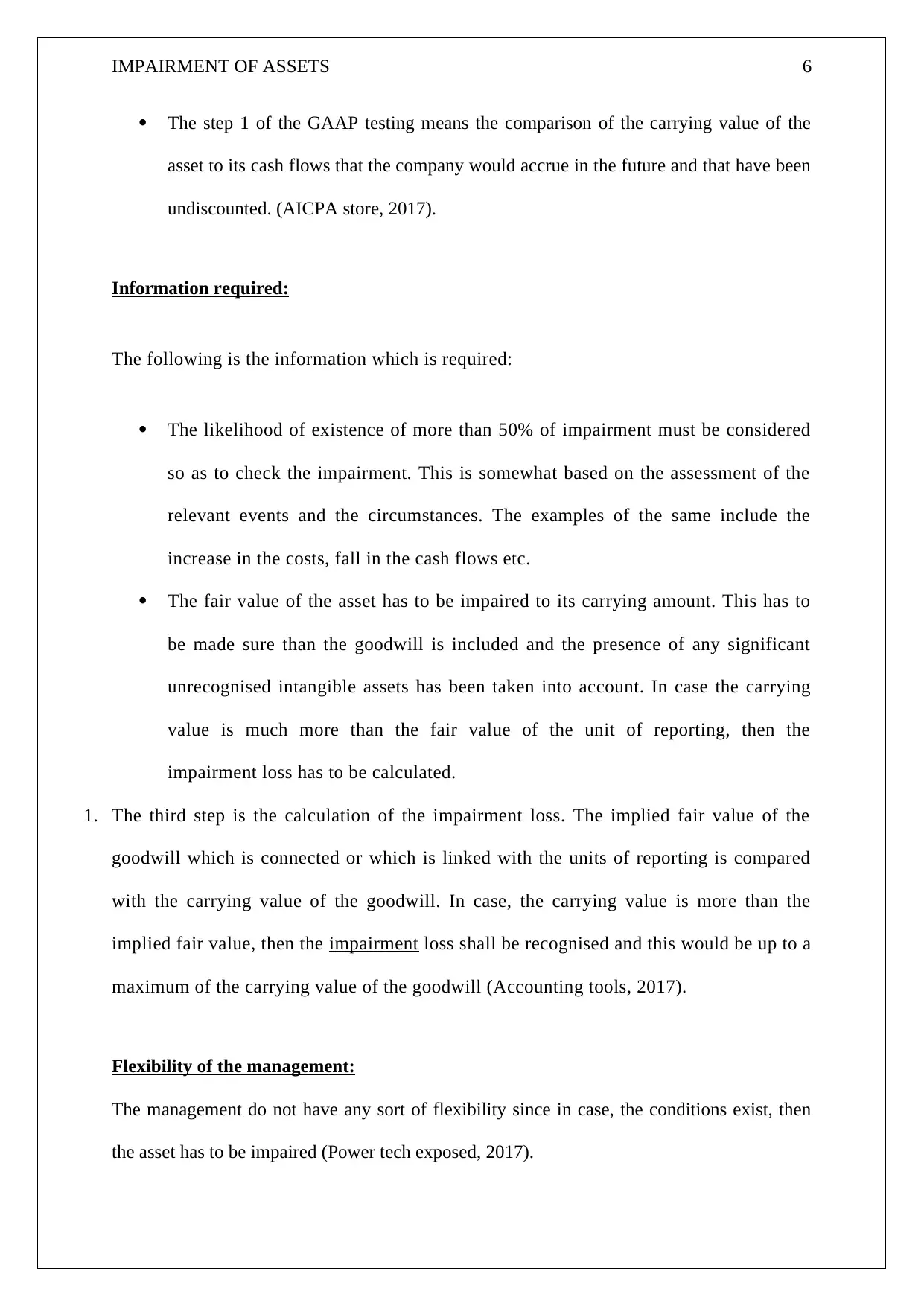
IMPAIRMENT OF ASSETS 6
The step 1 of the GAAP testing means the comparison of the carrying value of the
asset to its cash flows that the company would accrue in the future and that have been
undiscounted. (AICPA store, 2017).
Information required:
The following is the information which is required:
The likelihood of existence of more than 50% of impairment must be considered
so as to check the impairment. This is somewhat based on the assessment of the
relevant events and the circumstances. The examples of the same include the
increase in the costs, fall in the cash flows etc.
The fair value of the asset has to be impaired to its carrying amount. This has to
be made sure than the goodwill is included and the presence of any significant
unrecognised intangible assets has been taken into account. In case the carrying
value is much more than the fair value of the unit of reporting, then the
impairment loss has to be calculated.
1. The third step is the calculation of the impairment loss. The implied fair value of the
goodwill which is connected or which is linked with the units of reporting is compared
with the carrying value of the goodwill. In case, the carrying value is more than the
implied fair value, then the impairment loss shall be recognised and this would be up to a
maximum of the carrying value of the goodwill (Accounting tools, 2017).
Flexibility of the management:
The management do not have any sort of flexibility since in case, the conditions exist, then
the asset has to be impaired (Power tech exposed, 2017).
The step 1 of the GAAP testing means the comparison of the carrying value of the
asset to its cash flows that the company would accrue in the future and that have been
undiscounted. (AICPA store, 2017).
Information required:
The following is the information which is required:
The likelihood of existence of more than 50% of impairment must be considered
so as to check the impairment. This is somewhat based on the assessment of the
relevant events and the circumstances. The examples of the same include the
increase in the costs, fall in the cash flows etc.
The fair value of the asset has to be impaired to its carrying amount. This has to
be made sure than the goodwill is included and the presence of any significant
unrecognised intangible assets has been taken into account. In case the carrying
value is much more than the fair value of the unit of reporting, then the
impairment loss has to be calculated.
1. The third step is the calculation of the impairment loss. The implied fair value of the
goodwill which is connected or which is linked with the units of reporting is compared
with the carrying value of the goodwill. In case, the carrying value is more than the
implied fair value, then the impairment loss shall be recognised and this would be up to a
maximum of the carrying value of the goodwill (Accounting tools, 2017).
Flexibility of the management:
The management do not have any sort of flexibility since in case, the conditions exist, then
the asset has to be impaired (Power tech exposed, 2017).
⊘ This is a preview!⊘
Do you want full access?
Subscribe today to unlock all pages.

Trusted by 1+ million students worldwide

IMPAIRMENT OF ASSETS 7
Conclusion:
The main idea behind the principle of IAS 36 is the fact that an asset must never be reported
at more than its fair value. In case, the carrying value is more than the recoverable amount,
then the asset is stated to have been impaired. In such a case, the asset must be reduced to the
carrying value of the asset to its recoverable value and then the loss of impairment must be
reported in the statement of profit and loss as an impairment loss. This accounting standard
applies to certain group of the assets that do not generate the cash inflows individually such
as the cash generating units.
There are some of the conditions that exist on the basis of which an impairment is said to
have taken place. In case the carrying value of the asset is less than the fair value of an asset,
then the management has to impair that assets and reduce its carrying value to its fair value
the management as such has no flexibility in this regard, they merely have to comply with the
requirements of the accounting standards. The judgement has to resort to when it comes to
the exercising of the factors that would lead to the impairment of an asset. Though there are
some of the conditions that indicates an impairment but the management is duty bound to use
its judgement, past experiences, experiences of the similar companies in the same industry.
Conclusion:
The main idea behind the principle of IAS 36 is the fact that an asset must never be reported
at more than its fair value. In case, the carrying value is more than the recoverable amount,
then the asset is stated to have been impaired. In such a case, the asset must be reduced to the
carrying value of the asset to its recoverable value and then the loss of impairment must be
reported in the statement of profit and loss as an impairment loss. This accounting standard
applies to certain group of the assets that do not generate the cash inflows individually such
as the cash generating units.
There are some of the conditions that exist on the basis of which an impairment is said to
have taken place. In case the carrying value of the asset is less than the fair value of an asset,
then the management has to impair that assets and reduce its carrying value to its fair value
the management as such has no flexibility in this regard, they merely have to comply with the
requirements of the accounting standards. The judgement has to resort to when it comes to
the exercising of the factors that would lead to the impairment of an asset. Though there are
some of the conditions that indicates an impairment but the management is duty bound to use
its judgement, past experiences, experiences of the similar companies in the same industry.
Paraphrase This Document
Need a fresh take? Get an instant paraphrase of this document with our AI Paraphraser
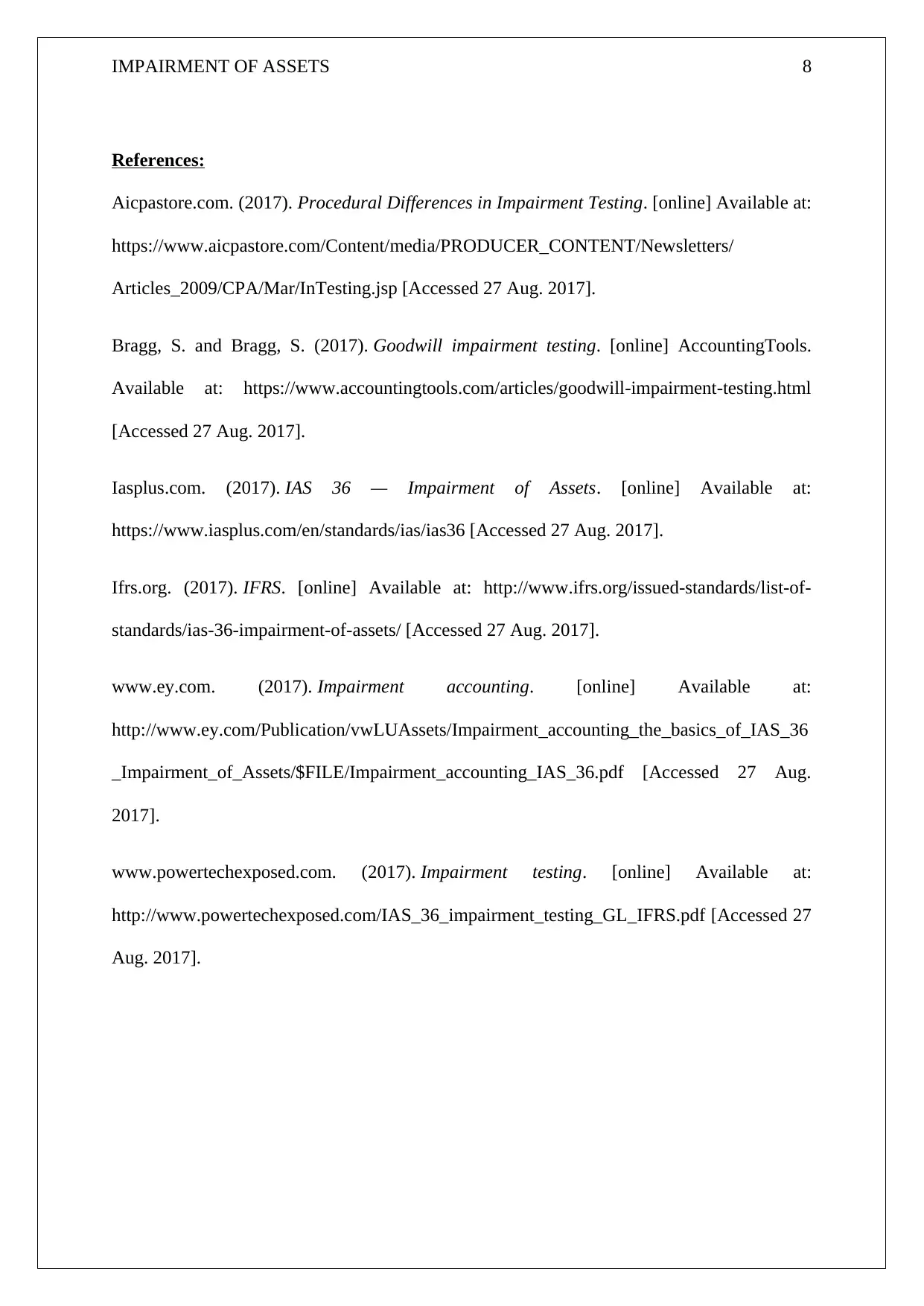
IMPAIRMENT OF ASSETS 8
References:
Aicpastore.com. (2017). Procedural Differences in Impairment Testing. [online] Available at:
https://www.aicpastore.com/Content/media/PRODUCER_CONTENT/Newsletters/
Articles_2009/CPA/Mar/InTesting.jsp [Accessed 27 Aug. 2017].
Bragg, S. and Bragg, S. (2017). Goodwill impairment testing. [online] AccountingTools.
Available at: https://www.accountingtools.com/articles/goodwill-impairment-testing.html
[Accessed 27 Aug. 2017].
Iasplus.com. (2017). IAS 36 — Impairment of Assets. [online] Available at:
https://www.iasplus.com/en/standards/ias/ias36 [Accessed 27 Aug. 2017].
Ifrs.org. (2017). IFRS. [online] Available at: http://www.ifrs.org/issued-standards/list-of-
standards/ias-36-impairment-of-assets/ [Accessed 27 Aug. 2017].
www.ey.com. (2017). Impairment accounting. [online] Available at:
http://www.ey.com/Publication/vwLUAssets/Impairment_accounting_the_basics_of_IAS_36
_Impairment_of_Assets/$FILE/Impairment_accounting_IAS_36.pdf [Accessed 27 Aug.
2017].
www.powertechexposed.com. (2017). Impairment testing. [online] Available at:
http://www.powertechexposed.com/IAS_36_impairment_testing_GL_IFRS.pdf [Accessed 27
Aug. 2017].
References:
Aicpastore.com. (2017). Procedural Differences in Impairment Testing. [online] Available at:
https://www.aicpastore.com/Content/media/PRODUCER_CONTENT/Newsletters/
Articles_2009/CPA/Mar/InTesting.jsp [Accessed 27 Aug. 2017].
Bragg, S. and Bragg, S. (2017). Goodwill impairment testing. [online] AccountingTools.
Available at: https://www.accountingtools.com/articles/goodwill-impairment-testing.html
[Accessed 27 Aug. 2017].
Iasplus.com. (2017). IAS 36 — Impairment of Assets. [online] Available at:
https://www.iasplus.com/en/standards/ias/ias36 [Accessed 27 Aug. 2017].
Ifrs.org. (2017). IFRS. [online] Available at: http://www.ifrs.org/issued-standards/list-of-
standards/ias-36-impairment-of-assets/ [Accessed 27 Aug. 2017].
www.ey.com. (2017). Impairment accounting. [online] Available at:
http://www.ey.com/Publication/vwLUAssets/Impairment_accounting_the_basics_of_IAS_36
_Impairment_of_Assets/$FILE/Impairment_accounting_IAS_36.pdf [Accessed 27 Aug.
2017].
www.powertechexposed.com. (2017). Impairment testing. [online] Available at:
http://www.powertechexposed.com/IAS_36_impairment_testing_GL_IFRS.pdf [Accessed 27
Aug. 2017].
1 out of 8
Related Documents
Your All-in-One AI-Powered Toolkit for Academic Success.
+13062052269
info@desklib.com
Available 24*7 on WhatsApp / Email
![[object Object]](/_next/static/media/star-bottom.7253800d.svg)
Unlock your academic potential
Copyright © 2020–2025 A2Z Services. All Rights Reserved. Developed and managed by ZUCOL.





